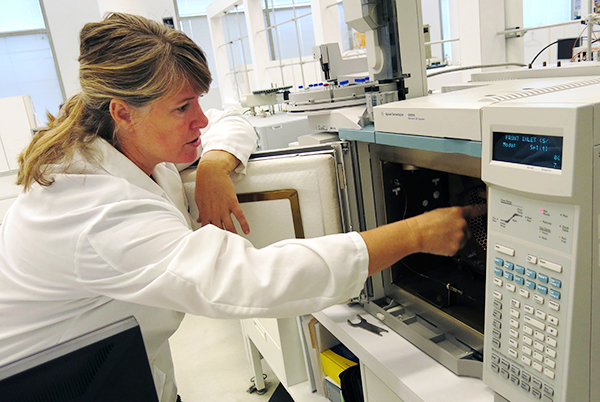Look into the work of the GCI with a new series spotlighting tools used by its staff. First up: the GC/MS instrument, which analyzes organic materials in artwork from the tiniest of samples

Joy Mazurek of the Getty Conservation Institute explaining what happens inside the GC/MS instrument during analysis.
Staff members of the Getty Conservation Institute (GCI) come from a great variety of disciplines. Chemists, architects, biologists, engineers, and other specialists lend their expertise to advance conservation of the world’s cultural heritage. Just as diverse as the staff’s backgrounds are the types of tools they use to aid the Institute’s conservation efforts. This is the first in a series of posts on The Getty Iris featuring the tools that are essential to the work of the Conservation Institute staff.
Joy Mazurek, a biologist by training, is an assistant scientist at the Conservation Institute. The tool she uses to conduct her scientific research is the Gas Chromatography/Mass Spectrometry (GC/MS) instrument. GC/MS, which combines two methods of analysis, is a technique that allows scientists to identify different organic compounds in an unknown sample. It is used for a wide variety of applications, such as testing an athlete’s blood or urine for drugs or tracking organic pollutants in the environment.
What Does the Tool Do?
To analyze works of art, Joy takes tiny samples—typically the size of a grain of very fine sand—from an inconspicuous spot in the work, such as along the edge of a painting or areas of loss around a crack, and runs them through the GC/MS instrument.
From this analytical data, she is able to identify the specific organic compounds in the materials used by the original artists, as well as by later hands such as restorers or conservators. Joy also looks for any microorganisms, such as fungus, that may be present on the artworks. These can be a source of discoloration or potential deterioration.

A look at Joy’s screen. Results of GC/MS analysis, shown here, are checked against a library of identified compounds provided by the National Institute of Standards (NIST).
How Does It Advance Conservation Practice?
Knowing the different components that make up an artwork is essential for conservators when deciding on the best treatment procedures and materials to use for conservation.
The results from Joy’s research not only inform conservation practice, but also the field of art history. For example, a team of scientists from Japan, Europe, and the Conservation Institute found that the wall paintings discovered inside the Bamiyan caves in Afghanistan were oil paintings dating from the mid-seventh century. This finding was both exciting and controversial for art historians, whose first evidence of oil paintings had previously been from 12th-century Europe.
The GC/MS instrument is essential for Joy. “I couldn’t do my work without it,” she says. She envisions a future in which the GC/MS instrument—which now resembles a slightly larger-than-average microwave oven—will be pocket-sized. “I can imagine a day when you could take the GC/MS machine with you, which would be great! You could take it to a remote heritage site, take a sample, and run it right there on the spot.”
Joy has been involved in training other scientists in how to use the GC/MS instrument and is currently developing analytical protocols that can be used by other museums.
Conservation Tools is an occasional series featuring tools essential to the work of the various specialists at the Getty Conservation Institute.




Comments on this post are now closed.